Star Gazing at Cheomseongdae – East Asia’s Oldest Observatory – Ancient Origins
The Korean peninsula is known for many things. One thing that may be less well known about Korean culture is its contribution to world astronomy. One particularly visible contribution is the oldest astronomical observatory in East Asia, Cheomseongdae. Cheomseongdae was built during the 7th century AD in what was then the Kingdom of Silla.
Ancient Korean Astronomy
Korean astronomical observations go back at least to the Stone Age , when ancient Koreans erected dolmens, which were aligned with various astronomical events. Many of these dolmens suggest the development of an astronomical tradition reaching far back into Korean prehistory.
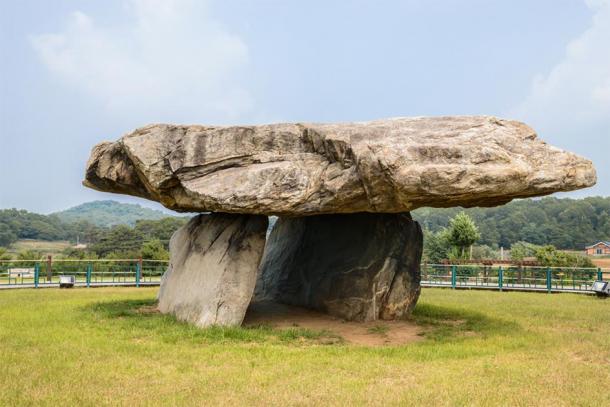
Ganghwa Dolmen is located in Incheon city, South Korea. ( / Adobe stock)
Agriculture was very important in ancient Korean society. Agriculture requires knowledge of the arrival of the seasons, which is aided by knowledge of astronomy. This led monarchs to invest in astronomy. Bureaus of astronomy were created. Observatories were built, and professional astronomers were employed to make observations.
Korean astronomy did not emerge in a vacuum. But instead, Korean intellectuals were in contact with Chinese intellectuals and borrowed many ideas from Chinese civilization, including ideas about astronomy.
While Korean astronomers compiled astronomical observations and systematized their knowledge of astronomy, they borrowed significantly from the Chinese when it came to cosmology. By the 7th century AD, however, the Korean astronomical tradition was almost as advanced and rich as that of China. It is in this context that Cheomseongdae was built.
The Korean Queen and Her Construction of Cheomseongdae
The construction of Cheomseongdae took place in 634 AD. It was built in the city of Gyeongju, the capital city of the Kingdom of Silla during the reign of Queen Seondeok (632-647 AD).
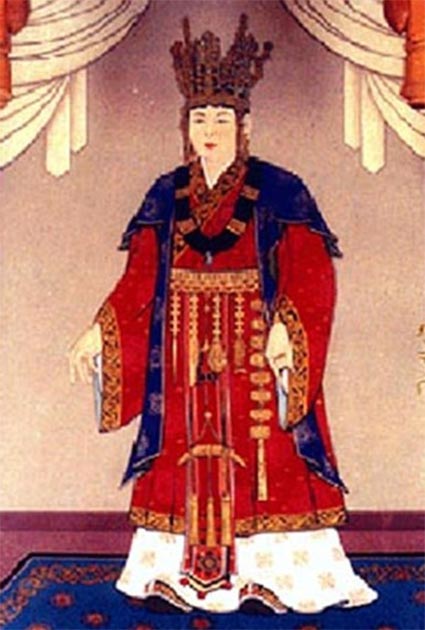
Queen Seondeok of Silla. ( )
Silla was one of the three major indigenous kingdoms in the Korean peninsula at the time. The region was divided between the three Korean states, Silla, Baekje, and Goguryeo, with the Tang Chinese intruding from the north.
Silla, according to tradition, was founded in 57 BC. By the 2nd century AD, Silla had formed into a confederation of tribes. The region was transformed into a unified kingdom ruled by a hereditary monarchy under King Naemul (356-402 AD). Silla continued to grow in military strength during the reign of King Pophung (514-540), who annexed the Kaya state.
By the 7th century, Silla was ruled by King Jinpyeong. Jinpyeong did not have any acceptable male successors and his daughter, Seondeok, was intelligent and of the right social rank, so she was chosen as queen in 632 AD.
The reign of Queen Seondeok was marked by violent conflicts with the surrounding kingdoms, but also by a renaissance of art, science and literature. Queen Seondeok is known for having built several Buddhist temples. She also sent scholars from her kingdom to study in China. She was very interested in Buddhism and is even said to have been ordained as a Buddhist nun, or bhikkhuni.
In addition to her interest in Buddhism, she also took an interest in astronomy and commissioned the construction of the Cheomseongdae observatory, the name of which means “Tower of the Moon and Stars” in Korean.
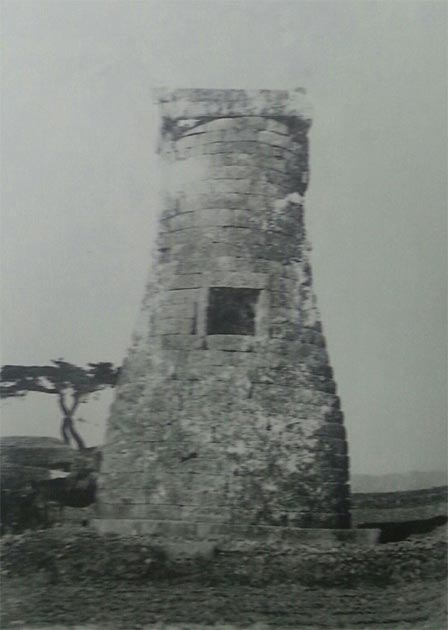
Historic photo of the Cheomseongdae observatory from the 1930s. (Roadgo / )
The Observatory and Its Symbolism
Cheomseongdae has retained its original appearance in the last 1,400 years since it was constructed. Because of this, it reveals valuable information about the nature of ancient Korean observatories to archaeologists. It should be noted that not all archaeologists have agreed that it was an observatory in the past, but this is the dominant view today because of historical and archaeological evidence.
Cheomseongdae is 9.17 meters (30 feet) in height. It consists of a stylobate, a bottle-like tower, and a square top. The square top appears to have been designed to represent a specific Chinese character. The tower is made up of 27 stone tiers, a design which symbolizes Queen Seondeok having been the 27th monarch of the Silla Kingdom.
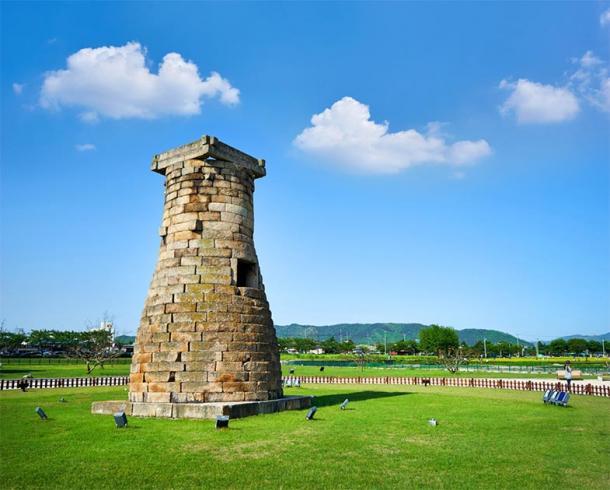
Cheomseongdae – the oldest astronomical observatory in East Asia. Daereungwon tomb complex, Gyeongju, South Korea. ( / Adobe stock)
There is a gap or hole in tiers 13 to 15 which is oriented slightly to the southeast. If the stylobate is included as another layer, in addition to the 27 stone tiers, the layers of stone represent the 28 traditional East Asian constellations. If all the layers of the stone tower are added, including the two tiers composing the top section, the layers add up to 30, which is the number of days in a lunar month. Interestingly, the square foundation is made up of 12 stones with three on each of the four corners. This could represent the 12 months of the year and the 4 seasons.
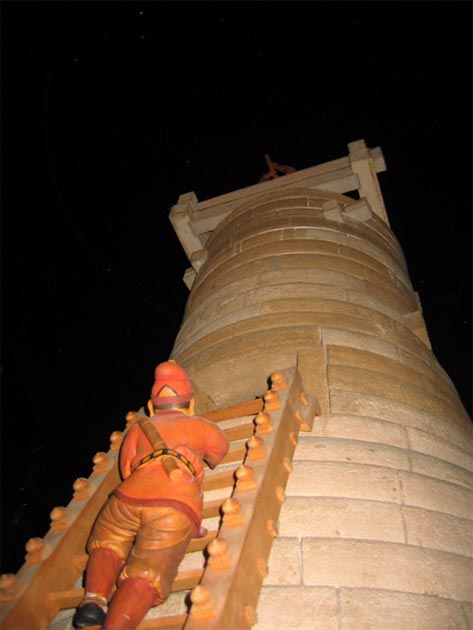
A scaled down model of Cheomseongdae showing its use as an observatory. ( Straitgate / )
The fact that the observatory is filled with symbolism suggests that there was at least some sacred significance to the observatory as well as scientific. Astronomy was not just important for agriculture and timekeeping in the ancient world, but also astrology. For this reason, the observatory likely also had political importance.
Ancient Korea’s Influences
How ancient Korean astronomers understood the universe appears to have been deeply influenced by Chinese cosmological ideas. Although Korean astronomers were adept at observing and studying the celestial bodies, they also appear to have borrowed significantly from Chinese cosmology.
Ancient Chinese cosmology differs from ancient Western cosmology in important ways. Before the beginning of the scientific revolution in the 17th century, Western cosmology was significantly influenced by ancient Greek ideas about the universe.
Ancient Greek Cosmology
The ideas of ancient Greek philosophers about the structure of the universe were diverse. Some of the pre-Socratic philosophers, such as Anaximander, believed that the Earth floated in a void. Others, such as Democritus, believed that the universe was made up of atoms. Others, such as Aristarchus of Samos, even suggested a heliocentric cosmology with the Sun at the center of the universe.
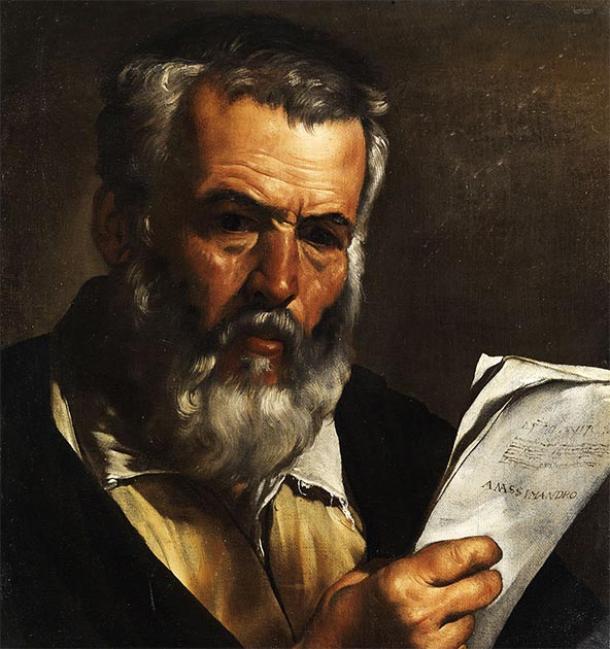
Portrait of the ancient Greek astronomer Anaximander. (Pietro Bellotti / )
The prevailing cosmological view in ancient Greek thought, however, especially by the Hellenistic period, was that the universe was finite with the Earth at or near the center. The fixed stars were attached to a rigid, crystal sphere. The Sun, the Moon, and the five visible planets of antiquity each had their own crystal sphere. In addition to the crystal spheres, the planets were also believed to be connected to smaller spheres, or epicycles, which caused retrograde motion of some planets, such as Mars.
The ancient Greeks appear to have been very interested in explaining the motion of the planets. They also had a preoccupation with the idea that the motion of the heavenly bodies and the shape of the heavens and the Earth had to all be spherical. This is because the sphere was considered to be the ideal shape in ancient Greek philosophy.
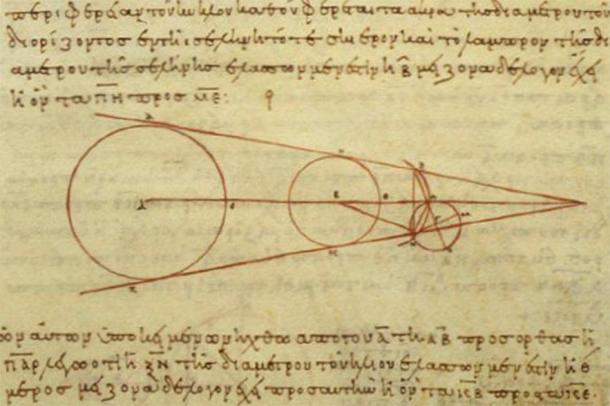
10th century AD Greek copy of Aristarchus of Samos’s 2nd century BC calculations of the relative sizes of the Sun, Moon and the Earth. ( )
The ancient Greeks believed that there had to be some sort of order in the universe. If they could not find regularity in the motion of the celestial bodies, it would have threatened the idea of an orderly universe. As a result, much of ancient Greek astronomy was focused on developing models for the motion of the celestial bodies, particularly the planets.
Chinese Ideas Differed in Significant Ways
Ancient Chinese cosmological ideas had similarities to Greek ideas, but they differed in significant ways. The cosmology that became dominant in ancient Greek astronomy was that of a spherical Earth and a finite spherical universe. Most Chinese cosmologies, on the other hand, held the Earth to be flat and the cosmos to be infinite. Chinese philosophers believed that the visible heavens and Earth were part of a comprehensible universe, beyond which was an infinite, unknown cosmos.
Ancient Chinese astronomers also seem to have had a different understanding of cosmic order. Unlike the Greeks, they did not see the irregularity of the motion of the planets to be a threat to the idea of cosmic order. Ancient Chinese astronomers and philosophers appear to have been less anxious to demonstrate an orderly universe through observations compared to the ancient Greeks.
Since China is much closer to Korea than Greece, it is Chinese cosmological ideas that influenced Korean astronomy. Before Western astronomy was introduced to East Asia in the 1600s by Jesuit missionaries, there were three prevailing cosmological models in Chinese cosmology.
A popular model was Gai Tian . In this view, the Earth was flat, and the heavens were a round dome overhead. This cosmological idea is not very different from flat Earth cosmologies that probably prevailed in ancient Greek thought before the round Earth theory became dominant.
Another common cosmological model was Hun Tian . According to this model, the heavens entirely surrounded a flat Earth, forming an egg-like structure. Earth was believed to be surrounded by water and the heavens were said to be filled with vapor, or chi.
A third, more abstract model was Shuen Ye, which did not say anything specific about the physical shape of the Earth or the heavens. This model focused on the infinite nature of the cosmos.
Unlike the Ptolemaic model, the heavenly bodies were considered to be free floating and not attached to anything solid, like crystal spheres. The celestial bodies were believed to move unhindered through the heavens.
Traditional Chinese astronomers, and consequently traditional Korean astronomers, do not appear to have been as interested in the position of the earth with respect to the rest of the universe as ancient Greek astronomers. This may be due the fact that Chinese and Korean astronomy tended to focus on observing the stars, such as pole star, whereas ancient Greek astronomy tended to focus on determining the position of the celestial bodies in reference to the Earth.
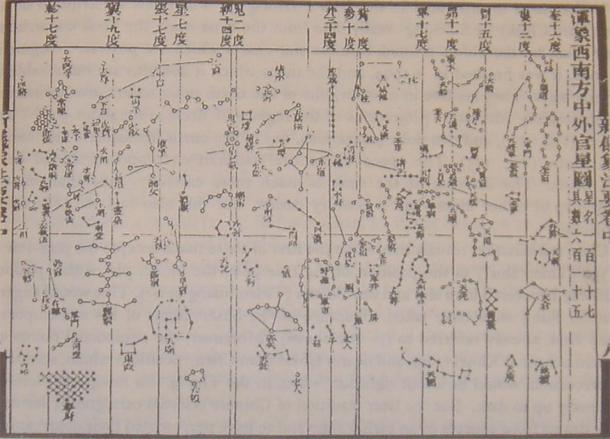
A star map with a cylindrical projection. The ancient Chinese Astronomer Su Song’s star map represents one of the oldest in existence in printed form. (PericlesofAthens / )
Another feature distinguishing ancient Chinese science and Western science is the attitude towards natural causes. The ancient Chinese do not appear to have focused as much on looking for laws governing nature. They didn’t deny that there were natural laws. They simply believed that these laws were too complex and subtle to ever be found out by humans. Chinese scientists focused instead on using science to come up with technology and other practical endeavors. It is likely that this feature of Chinese science was also transported into Korean astronomy.
Korea’s Own Contributions
It is clear from the symbolism built into the Cheomseongdae observatory, that Korean astronomers were influenced by Chinese astronomy. Koreans nonetheless made their own contributions to astronomy and one of the oldest observatories in the region is in fact a Korean construction.
Beginning in the 17th century, Korean astronomers were exposed to Western astronomy by communication with Jesuit scholars. It did not take long for Western cosmological ideas to become popular among Korean astronomers. Since then, Korean astronomers have made many contributions to modern astronomy.
Cheomseongdae is no longer in use, but it symbolizes the long tradition of scientific discovery in the Korean peninsula. Today, Korean astronomers continue to contribute to our knowledge of the universe through organizations such as the Korean Astronomy and Space Science Institute of South Korea.
Cheomseongdae and World Astronomy
The Cheomseongdae observatory is important not only for telling the story of the history of astronomical knowledge in Korea, but also for its importance in being an early scientific observatory.
Archaeological remains of ancient observatories have been found in many cultures in Europe, Asia, the Americas, and elsewhere, but many of these structures were not primarily observatories. Observing the heavens was only part of their function. For example, many of them were mainly temples or other ritual sites.
Stonehenge, for example, appears to have been a possible solar observatory built over 1500 years between about 3000 BC and 1500 BC. It is likely, however, that Stonehenge was mainly built for religious purposes since it appears to be part of a larger sacred landscape. Stonehenge was likely just as much a temple as it was a solar observatory for marking cyclic changes in the Sun’s position.
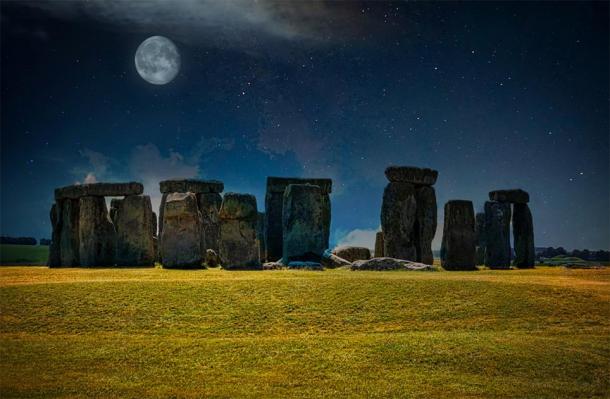
Stonehenge at night with stars and the Moon in the sky. ( / Adobe stock)
Another example would be the Newgrange Passage Tomb in Ireland. The passage tomb was built around 3200 BC. It is significant to archaeoastronomers because the tomb seems to have features that were specifically aligned to be illuminated on the winter solstice. Despite these alignments, the tomb clearly served other purposes than marking the motion of the Sun. The same is true for many other ancient monuments of astronomical significance. They were religious or burial structures that also served to mark the motion of the celestial bodies.
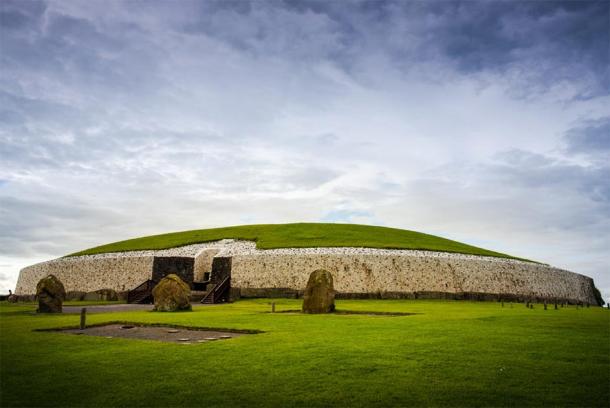
Newgrange Passage Tomb in the Boyne Valley in Ireland. ( / Adobe stock)
Cheomseongdae represents an early example of a building that was entirely dedicated to astronomical observing, even if it may have also had some sort of sacral or political significance. In this way, Cheomseongdae represents an archaeoastronomical milestone for East Asia as being one of the oldest surviving scientific observatories in that region.
Top image: Cheomseongdae observatory at night, Gyeongju, South Korea. Source: / Adobe stock
By Caleb Strom
References
Berryman, Sylvia. 2006. Democritus. Stanford Encyclopedia of Philosophy. Available at:
Cummings, Vicki. 2015. Dolmen. Encyclopedia Britannica. Available at:
Evans, James. 2019. Anaximander. Encyclopedia Britannica. Available at:
Evans, James. 2020. Aristarchus of Samos . Encyclopedia Britannica. Available at:
Liu, Shu-Chiu. 2006. Historical Models in the European and Chinese Contexts . Asia-Pacific Forum on Science Learning and Teaching. Available at:
Liu, Shu-Chiu. 2006. Three early Chinese models . Asia-Pacific Forum on Science Learning and Teaching. Available at:
N.A. N.D. About KASI. Korea and Astronomy Space Science Institute. Available at:
N.A. N.D. Anaximander. Swinburne University of Technology SAO Encyclopedia of Astronomy. Available at:
N.A. N.D. Category of Astronomical Heritage: tangible immovable Cheomseongdae observatory, Republic of Korea. Astronomical Heritage. Available at:
Nha, Il, Seong. 1997. Astronomy in Korea . The Third Pacific Rim Conference on Recent Development of Binary Star Research. Available at:
Park, Changbom. 2008. Traditional Korean Astronomy: Science of the Heavens . KIAS Newsletter History of Mathematics & Astronomy in Korea. Available at:
Scherrer, Deborah. 2018. Ancient Observatories Timeless Knowledge . Stanford Solar Center. Available at:
The Editors of Encyclopaedia Britannica. 2015. Silla . Encyclopedia Britannica, Available at:
The Editors of New World Encyclopedia. 2015. Queen Seondeok of Silla. New World Encyclopedia. Available at:
Van Helden, Al. 1995. Ptolemaic System . Rice University, The Galileo Project. Available at:






